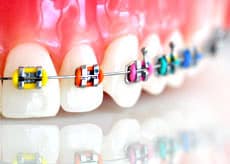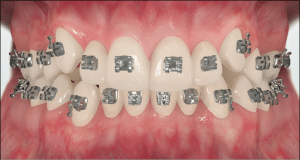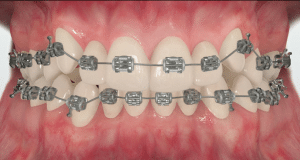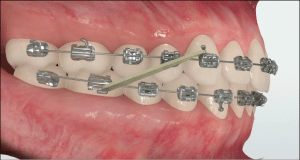Adult Metal Braces
Adult metal braces are made from stainless steel and standard method of aligning teeth and correcting bites. Each individual metal brace we use comes in its own single use sealed package to ensure that it is contamination and tamper free. These adult braces are low profile, allowing your lips to easily adapt to them.
Equipment
Orthoclinic uses state of the art equipment and bracket systems for adult braces which can provide faster results with fewer appointments and less treatment time. Our nickel titanium alloy orthodontic wires ensure rapid alignment and unique to Orthoclinic, Dr Madsen’s skilled manual fine tuning ensure you will receive top quality results in a minimum of time.
Durable and strong
Traditional metal or wired braces are known for their durability and longevity. Made from strong materials like titanium and stainless steel, they’re designed to withstand the daily wear and tear of brushing and chewing. They provide reliable and effective tooth alignment throughout your entire treatment duration.
Colours
 These adult metal braces require a rubber ring to hold the orthodontic wire in place. Those rubber rings can be any colour you wish, including conservative clear to out there bright colours.
These adult metal braces require a rubber ring to hold the orthodontic wire in place. Those rubber rings can be any colour you wish, including conservative clear to out there bright colours.
For those who are more adventurous, we have a full range of colours to choose from as follows:

How Do Adult Braces Work?
1. Braces are initially glued on to each tooth individually using a special clear glue that bonds to the enamel of your teeth.

2. Flexible shape memory wires are inserted into the braces.

3. As these shape memory wires straighten out to their original shape, they gently pull the teeth with them slowly aligning the teeth over time

4. Once the teeth are straight, other more complex tooth movements are achieved with small add-ons to the braces. For example, elastic bands are sometimes placed onto the side of braces to achieve relative movement of the upper teeth to the lower teeth.

Comfort
Placement of braces on teeth is a simple process with a minimum of discomfort for our adult patients. However, during the first few days of tooth movement it is normal to experience a low grade ache, and tenderness to chewing foods. Once this subsides, treatment will progress with minimal discomfort or disruption to eating & speaking. It is uncommon for adults to have persistent problems with braces throughout treatment.
Treatment Times
Treatment times with adult braces vary depending on the complexity of each case and what the treatment objective are. While adult teeth sometimes move slower than in children, simple alignment cases can take less time than six months to complete. Complex cases involving coordination between other specialties can take up to 24 months in treatment.
Orthoclinic is Canberra adult braces specialist. Book now for a consultation with Dr Madsen.
Childrens
Looking for Braces for your child or teen? View our Children’s Braces Treatment.
Why Choose Orthoclinic For Your Braces?
Quick results
You can expect quick and impressive results with metal braces; they are designed for efficient orthodontic treatment. Unlike removable braces, traditional “fixed” braces exert constant pressure on your teeth. While treatment time varies, braces are generally the fastest option for major corrections.
Affordable
These braces are a cost-effective choice compared to many other treatment options. Clear aligners, ceramic braces and lingual braces are significantly more expensive.
The good news is that many insurance companies recognise the importance of adult orthodontic treatment and may contribute to the cost.
A Happier, Healthier Smile
By choosing to straighten your teeth with braces, you’re not only improving the appearance of your smile but also protecting your oral health in general. Straight teeth are easier to brush and maintain, reducing the risk of bad breath, gum disease, and tooth decay.
Comfort And Aesthetics
We all know how “old-fashioned” braces look. And, while they’re an affordable and effective option, many adults avoid them due to their noticeable appearance. This is especially true in professional settings.
The good news is that orthodontic treatment has come a long way. Today, mini braces are smaller and less noticeable – a great aesthetic benefit for those who prioritise appearance.
If you want a completely discreet treatment option, clear ceramic braces, invisible braces like Invisalign, or lingual braces are great alternatives. Ceramic braces match the colour of your teeth, while clear aligners are virtually invisible trays. Lingual braces are similar to traditional, wired braces but are placed behind your teeth.
Besides aesthetics, comfort is another concern of adults with orthodontic treatment needs. While it’s normal to feel some initial discomfort when you first get braces or after adjustments, this usually improves as you get used to them.
It’s important to remember that you deserve a healthy smile at any age!
Common Questions
Does it hurt to eat with braces?
When braces are first placed, it may take some time to get used to them and adjust your eating. During the first few hours of wearing braces, you might feel a bit uncomfortable and take longer to eat, but you will adapt. You might also notice some extra sensitivity in your teeth at first, which should subside as time passes.
Are there food restrictions with metal/wired braces?
Yes. Crunchy and sticky foods like nuts, chewing gum, hard candies, and popcorn are best to be avoided when you have braces. These can potentially loosen or damage the brackets or wires and lead to delays in your treatment.
How do I care for my teeth if I have braces?
Taking care of your oral hygiene is crucial whether you have braces or not. While undergoing treatment, orthodontic patients must adapt their brushing and flossing techniques to keep their teeth and gums healthy. We’ve put together a handy oral hygiene guide, to assist you care for your teeth.
- Brushing techniques – Brush your teeth twice a day with a soft-bristled toothbrush. Pay special attention to cleaning around the brackets and wires. Consider using specialised orthodontic toothbrushes or interdental brushes to remove food build-up effectively.
- Flossing – Flossing becomes even more important when you have braces. Use floss threaders or orthodontic floss to clean around the braces and hard-to-reach areas.
- Interdental cleaning – In addition to brushing and flossing, you can try other cleaning tools like internal brushes or water flossers. These are great for removing plaque and food particles.
- Regular check-ups – Schedule regular appointments with your dentist to monitor and maintain your oral health, receive professional cleaning, and review any concerns you may have about your treatment.
By taking good care of your oral hygiene during orthodontic treatment, especially your adult teeth, you’ll keep your smile healthy and achieve the best possible outcome.
